Why It’s Important to Brush Your Cat’s Teeth
The thought of trying to brush your cat’s teeth may seem daunting. But keeping their teeth clean is more important than you may think.
The thought of trying to brush your cat’s teeth may seem daunting. But keeping their teeth clean is more important than you may think.
by Adrienne A. Kruzer, BBA, RVT, LVT, | April 23, 2025

Jeanette Virginia Goh / Shutterstock
In the wild, cats use their teeth to tear through flesh and rip meat off the bones of their prey. These natural actions help keep their teeth free of plaque and tartar. As a pet, though, your cat doesn’t have to work as hard to get their meals, especially if they are an indoor-only cat. So, how often should you brush your cat’s teeth and how do you get your cat on a doable dental regimen? We explain it all, below.
The soft, easy-to-eat food most cats eat today contributes to food particles, saliva, and bacteria building up on their teeth. All of the above can turn into plaque and eventually harden and mineralize into tartar buildup. Without brushing your cat’s teeth, this plaque and tartar can then contribute to serious health issues. In 2023, 64 percent of cats seen at Banfield were diagnosed with dental-related issues. Even more alarming? Cats with advanced periodontal disease were 1.5 times more likely to develop chronic kidney disease. Brushing your cat’s teeth isn’t just about keeping their smile cute — it can actually help protect their overall health.
If possible, you should brush your cat’s teeth every day. But at a minimum, it’s recommended that you brush your cat’s teeth three times a week. “Less frequently than that is likely not having much effect in preventing periodontal disease because the goal of brushing is to remove new deposits of plaque bacteria before they have the chance to harden into calculus on the teeth and to colonize the space underneath the gumline,” says Dr. Leah Taylor, a board-certified veterinary dentist at Texas A&M University’s Small Animal Dentistry and Oral Surgery center.

Banfield Pet Hospital® is offering new clients a coupon for a free first veterinarian visit! (Terms apply.) Book yours now at one of their 1,000+ locations.
Bacteria, saliva, and food particles build up in your cat’s mouth daily. It doesn’t take long for this accumulation to mineralize and harden into tartar, so it’s important to remove it before this happens. “The timeframe for that is 24 to 48 hours after the tooth is cleaned,” Dr. Taylor says.
“Brushing in pets is typically focused on the outside of the teeth (those facing the cheek) and the studies have been focused on brushing each tooth surface at least three times,” Dr. Taylor says. “This is likely going to be quicker than the two-minute brushing sessions recommended for humans.”
Try to brush your cat’s teeth each day for about 15 to 30 seconds on each side of their mouth. You may need to work your way up to this amount of time, but even five to 10 seconds per side will be helpful.
Despite the need for daily toothbrushing, if your cat’s mouth is painful for any reason, you should stop brushing their teeth until the issue is resolved. This may occur when your kitten is temporarily cutting a new tooth, due to an injury near or in the mouth, or if they have periodontal disease.
Typically, adult cats have 30 permanent teeth (12 incisors, four canines, four molars, and 10 premolars).
Dental disease occurs in 50 to 90 percent of cats over the age of four, so it’s likely that your adult cat will experience some sort of dental disease as they age. There are three common dental problems that can affect your cat: gum inflammation, periodontitis, and tooth resorption. “In cats, tooth resorption is a common dental disease that is similar to a deep cavity and is very painful,” Dr. Taylor explains. “Some of these lesions can only be identified on x-ray, making annual dental cleanings under anesthesia with x-rays essential in keeping your cat pain-free.”
Your cat may also experience bad breath and pain alongside those issues and cats are very good at hiding things from you. That’s why it’s important to know what to look for. Signs of dental issues can include:
Bad breath can occur after your cat eats something, especially something stinky. But if their bad breath is persistent and worsening, this can indicate a serious issue inside your cat’s mouth.
Excessive drooling
Blood in your cat’s mouth (or in their saliva or on the fur where they clean themselves)
Difficulty chewing (including pain while chewing or chewing on just one side of their mouth) and an overall reluctance to eat

Banfield Pet Hospital® can help your pet live their happiest, healthiest life. Read more vet-approved healthy tips and tricks on how to best care for your BFF.
Regular toothbrushing freshens the breath and removes food particles, bacteria, and plaque from your cat’s teeth. Additionally, the brushing action helps prevent hard tartar from forming on your cat’s teeth, and it deters serious periodontal, heart, kidney, and liver disease that can result from bacteria buildup in their mouth. These serious health problems can lead to pain, tooth decay, bone loss, heart failure, kidney failure, and liver inflammation.
Even if you brush regularly, your veterinarian may need to anesthetize your cat to properly clean and examine their teeth. Still, with good, at-home dental hygiene practices, your cat is less likely to need dental extractions, antibiotics, pain medications, and other oral procedures that may hurt your wallet.
When starting a toothbrushing routine for your cat, it’s essential to take it slow and ensure the experience is positive for them. Start brushing your cat’s teeth as early as possible. Introducing them to toothbrushing when they are kittens helps them get used to the experience. If your cat is already an adult, find a toothpaste flavor they enjoy, give them ample praise and treats while you practice brushing, and take things slowly. “It may take several weeks to get them comfortable with the toothbrush. Never risk your own or your cat’s well-being to brush when they aren’t ready,” Dr. Taylor says.
Here are some steps to help get your cat’s dental health on track.
Gather your gear: You’ll need a cat-sized toothbrush and toothpaste made specifically for cats. Never use human toothpaste.
Help your cat get comfortable with lip and mouth touch: Start by gently lifting their lip and touching around their mouth during calm moments. The goal is for them to become less weirded out by this interaction. Use treats, petting, and verbal praise to help make this a positive experience. Be sure to stop if they show signs of fear, and try again later.
Introduce the toothpaste: “There are many cat-friendly flavors available, including chicken and beef. I have also found the vanilla mint flavor to be popular even amongst cats,” Dr. Taylor says. Once you pick a toothpaste, let your cat sniff or lick the toothpaste off your finger — that’s a great first step.
Introduce the toothbrush to your cat: Allow your cat to sniff and lick the toothbrush. Provide more treats, petting, and verbal praise as your cat shows interest in the toothbrush and toothpaste.
Finally, begin brushing your cat’s teeth: Gently hold your cat’s head so you can keep their mouth shut and slide the toothbrush into the corners of their mouth. Start by brushing just one or two teeth near the front using small, gentle strokes. That’s it. You’re not going for a full cleaning right away. Over time, you can work your way to more teeth as your cat gets more comfortable with toothbrushing and associates it with treats and praise.
While there is no replacement for daily toothbrushing, there are some other products that can help keep your cat’s teeth clean. “There are many options, and the goal is to use two to three methods of dental health home care, even if your cat will accept toothbrushing,” Dr. Taylor explains. Whether you use dental chews or oral rinses, they each help support oral health in different ways.
“They work either by mechanically removing plaque or chemically to address the factors in the oral cavity that allow calculus formation. The website VOHC.org maintains a list for both cats and dogs of dental products that have undergone studies to ensure their effect on periodontal disease,” Dr. Taylor says. Here are a few items to consider:
If your cat likes to chew on things and eat crunchy treats or food, there are a few options to support their oral health. Dental chews and treats are not replacements for brushing your cat’s teeth, but they can help. Talk to your veterinarian about whether or not your cat could benefit from a therapeutic oral-health diet, and look for the Veterinary Oral Health Council (VOHC) seal on treats and chew packages.
The VOHC also supports some oral rinses and gels that you can safely use in your cat’s mouth. These products will not replace daily brushing, but can help freshen breath and kill bacteria.
A professional dental cleaning at your veterinarian’s office will do more than any at-home toothbrushing could ever accomplish. These cleanings will require your cat to be put under general anesthesia. This allows your veterinarian to fully examine their teeth both above and below the gumline.
And if you’ve adopted an older cat, a professional cleaning can help you get off on the right foot. “Ideally, with older cats, it would be a good idea to have their teeth cleaned with full mouth x-rays, and any treatment of painful areas performed prior to starting brushing to give you a clean slate to prevent plaque formation and to remove areas where brushing might cause pain,” Dr. Taylor explains.
If your cat won’t let you brush their teeth, look for a treat, food, chew, gel, or rinse with a VOHC seal of approval, which will provide them with some oral health care.
No, human toothpaste can contain ingredients that are toxic to your cat. But at minimum, the flavors are likely to make your cat gag and vomit.
No, baking soda can not only upset your cat’s stomach, but it also doesn’t taste good and is likely to make your cat vomit.
You may need to experiment with toothbrush types to find the one that works best for you and your cat. Finger toothbrushes and small-head toothbrushes tend to be favorites.
Yes, if you want to do what you can to help avoid gingivitis and periodontitis in your cat, it is necessary to brush their teeth.
Cats are usually great at keeping themselves groomed. But if your cat has long hair or isn’t able to groom themselves very well, you may need to brush them at least once a week, if not more.
Plaque, tartar, and gingivitis are key signs that your cat needs more frequent toothbrushing. If your cat’s teeth aren’t white, and their gums are bright red, don’t ignore this.
Now is the best time to start brushing your kitten’s teeth. Getting your kitten used to having their teeth brushed while they are young is much easier than waiting until they are an adult.
If you don’t brush your cat’s teeth regularly, plaque will start to build up. The plaque will turn into tartar and result in gum inflammation. If these issues aren’t addressed, bacteria from the plaque and tartar will enter the bloodstream and can cause organ issues, tooth decay, jaw bone loss, and pain.
Talk to your veterinarian about how often your cat may need a professional dental cleaning. Some cats will benefit from one every year, while others may need them more or less frequently.
While toothbrushing is best, there is scientific evidence that a type of seaweed called Ascophyllum nodosum can improve a cat’s dental health. It can be purchased as a powder or found in some treats and food. Other plants are sometimes advertised to help with oral health in cats if they chew on them, but proof of efficacy and safety is often lacking.
Yes, wet food can contribute to gingivitis if you never brush your cat’s teeth. This is because wet food does not provide any natural crunching or scraping action on your cat’s teeth, so plaque is more likely to build up. And this can contribute to gingivitis.
“Brushing Teeth in Cats | VCA Animal Hospital.” Vca, vcahospitals.com/know-your-pet/brushing-teeth-in-cats.
Banfield Pet Hospital. “State of Pet Dental Health: Significant Majority of U.S. Dogs and Cats Have Oral Health Issues.” Banfield Pet Hospital.” Banfield Pet Hospital, 16 Feb. 2024, www.banfield.com/about-banfield/newsroom/press-releases/2024/state-of-pet-dental-health. Accessed 23 Apr. 2025.
Cornell Feline Health Center. “Feline Dental Disease.” Cornell University College of Veterinary Medicine, 4 Oct. 2017, www.vet.cornell.edu/departments-centers-and-institutes/cornell-feline-health-center/health-information/feline-health-topics/feline-dental-disease.
“Don’t Brush off Your Cat’s Dental Health.” VMBS News, 13 Feb. 2020, vetmed.tamu.edu/news/pet-talk/dont-brush-off-your-cats-dental-health.
Gawor, J, and M Jank. “Ascophyllum Nodosum as a Nutrient Supporting Oral Health in Dogs and Cats: A Review.” Polish Journal of Veterinary Sciences, 2023, pp. 511–520511–520, journals.pan.pl/dlibra/show-content?id=128558, https://journals.pan.pl/publication/145053.
Gomes, Holly. “Cat Dental Care – How to Get a Healthy Feline Smile.” The Cat Ladies, 29 Aug. 2022, thecatladies.com/blogs/news/cat-dental-care-cherish-those-pearly-whites.
“Toothbrushing for Dogs and Cats - Veterinary Medicine at Illinois.” Veterinary Medicine at Illinois, 2021, vetmed.illinois.edu/pet-health-columns/toothbrushing-for-dogs-and-cats.

Adrienne Kruzer is an accomplished veterinary technician and writer with over 15 years of hands-on experience caring for domestic and exotic animals.

Adoption Advice

Adoption Advice
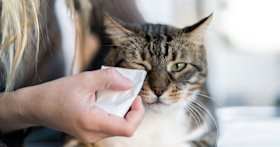
Pet Wellness
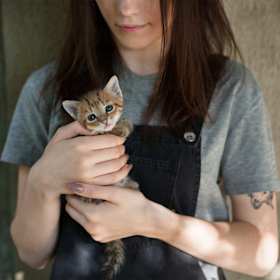
Adoption Advice
Your guide to everything you need to know — because preventing kitten health problems is far less expensive (and easier) than treating illnesses
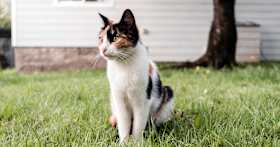
Adoption Advice
Life with an FIV+ cat isn’t so different after all
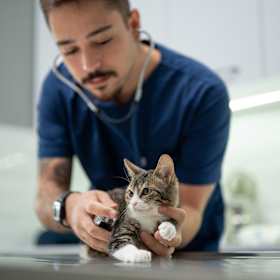
Adoption Advice
Preparing for a kitten’s first vet visit. Learn about what you can expect from a vet visit and what you should do to ensure it goes smoothly.

Adoption Advice
Stable personalities, chill dispositions, totally trained — adopting an older cat can be a smart move. Here’s everything you’ll need to know before adopting a senior kitty.

Adoption Advice
With some patience and a well-informed approach, it is absolutely possible to adopt a stray cat.
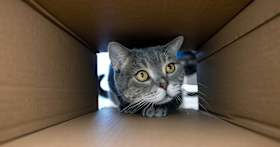
Behavior & Training
Cats may not need a lot of space, but it’s what you do with it that matters. Read on for tips to keep your cat mentally and physically at ease.